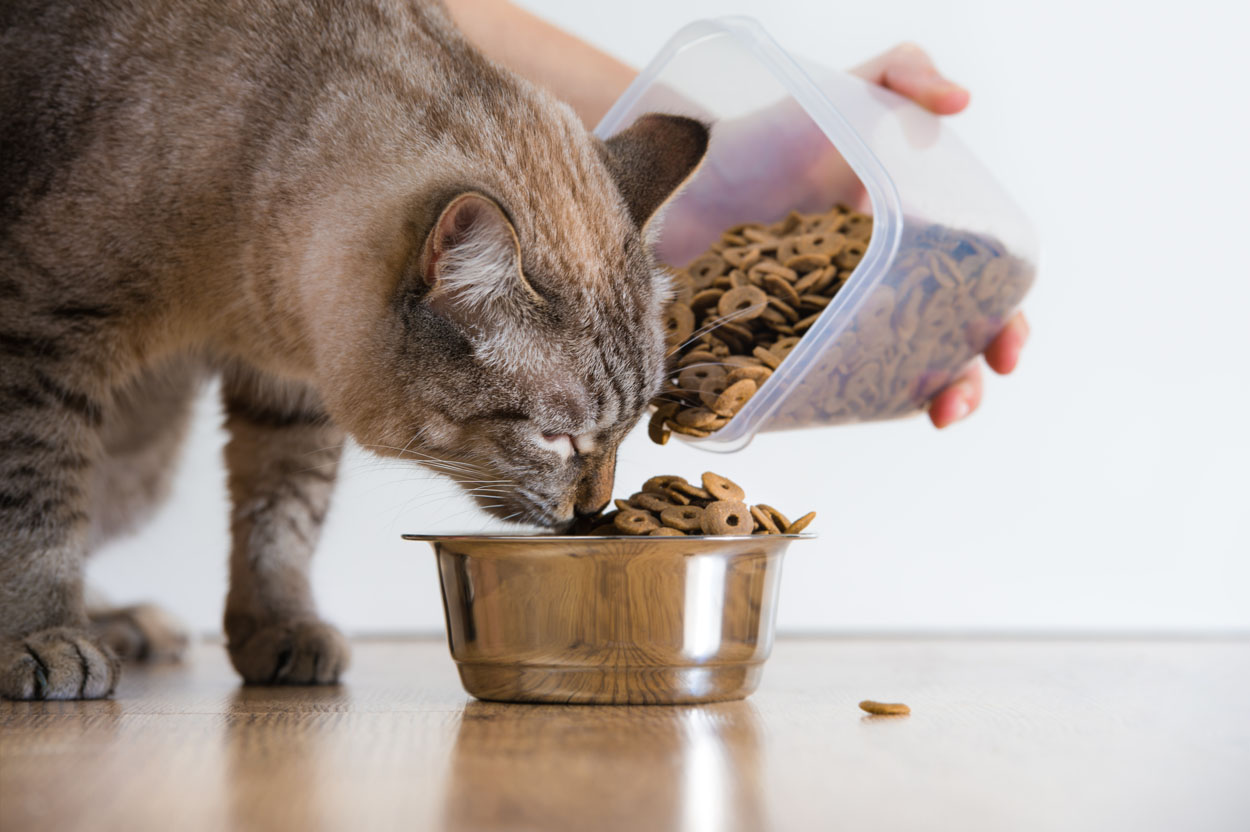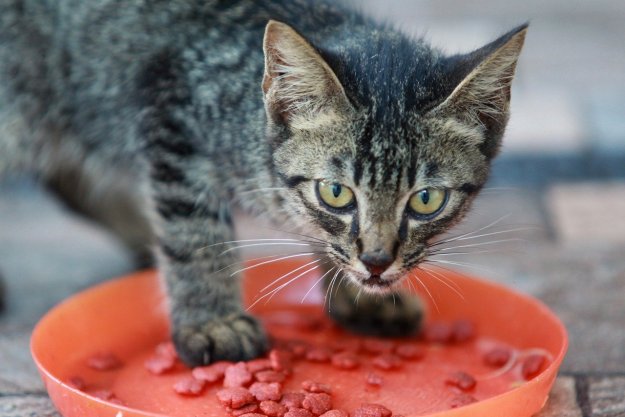
We love our little feline darlings. But hitting the market every day for fresh food gets expensive. One of the easiest ways to save money is to purchase large bags of dry cat food. But how to protect that investment and keep the food from getting stale, moldy, or (worst of all) soggy? Food storage containers solve the problem beautifully. These handy, helpful bins let you maintain weeks’ or even months’ worth of dry food, all fresh as the day you open the bag. We have seven different cat food storage options to choose from, catering to different owners’ needs.
- Why use food storage containers?
- 1. The automatic feeder
- 2. The hefty food storage container
- 3. The measured food storage container
- 4. The metal food storage container
- 5. The plastic food storage container
- 6. The split-level food storage container
- 7. The stackable food storage container
- Storage to the rescue!
Why use food storage containers?
Keeping open bags of cat food presents several problems for owners:
- Clutter: Depending on how many pets you have in your house, bags pile up.
- Waste: Spoiled food is money out the window. Some bags come with resealable options, but none of them provide airtight seals, and you don’t want your cat to inadvertently eat rotten food.
- Risk: Clever cats quickly learn how to scratch into a bag of dry food. You may come home to find cat food spilled across the floor — not to mention a seriously full kitty.
Food storage containers help prevent all these problems. Regardless of the design you choose, your cat’s food stays tucked away. Each time you open the container, your cat gets a fresh scoop of food. And even the smartest cats struggle to figure out latches on storage, keeping food safely out of reach.
So, let’s dive into seven types of cat food storage containers and see which might fit you and your cat the best.
1. The automatic feeder
Automatic feeders make excellent food storage devices. Depending on the style, they’ll hold an entire bag of food without a problem. You have simple gravity-style feeders, which keep the bowl full at all times (not the best option for cats prone to overeating). Or you can splurge and get a programmable automatic feeder. With such options as recordable messages, cameras for checking on your pets, and multiple feeding settings, the sky’s the limit for handy features! Automatic feeders don’t always form the most airtight seals, though. And some are trickier to clean than others. Look your choice over carefully before you buy.
2. The hefty food storage container
If you have more than one cat, odds are that you buy cat food in bulk. And while a cabinet full of neatly stacked plastic containers might not look bad, you probably don’t want to sacrifice half your kitchen to cat food storage. The Bergan Smart Storage eases your concerns. Because it holds up to 50 pounds of dry cat food, you can afford to bring home the jumbo bag. The easy-access flap accommodates a scoop without a problem, letting you dish out food to everyone at one time — without taking up the entire kitchen with cat food.
3. The measured food storage container
No one likes admitting their cat needs to lose a few ounces. And pouring out a diet-size portion of dry food through a tub or open bag gets difficult. Having a built-in measuring cup takes the guesswork out of diet regulation. Pission’s Pet Food Storage Container secures a measuring cup into the lid. The pour spout makes feeding time even easier, risking fewer chances of kibble spilling onto the table or floor. You even get a grooved handle for a sure hold. For people concerned with precise food portioning, this food storage container earns top marks.
4. The metal food storage container
Plastic may rule supreme when it comes to cat food storage containers, but not everyone likes that look in their kitchen. If you prefer a shinier aesthetic, you can find metal storage containers. They aren’t as airtight, but they have smoother interiors, which makes them easier to clean. Just make sure you opt for stainless steel or lead-free carbon steel when you’re shopping. Other base-metal options will start to rust over time, and your pets could end up with harmful chemicals leaching into their food.
5. The plastic food storage container
BPA-free plastic bins with a latched lid represent the most common cat food storage container. These plastic containers have the best airtight seals, keeping your cat’s food fresh every time you pop it open. The IRIS USA Airtight Food Storage Container works for the owner who wants to minimize kitchen clutter. The low profile fits neatly into a cabinet or on the shelf. The smooth sides prevent kibble from getting trapped into corners, allowing easy cleaning (always an important detail).
6. The split-level food storage container
Plenty of people own dogs and cats. But dog food and cat food bags come in different sizes. If you want to take care of the entire family at one time, consider a food storage container along the lines of the IRIS USA 3-Piece Airtight Pet Food Storage Container. Two separate compartments allow you to store your dog’s and cat’s foods in one handy place. The wheels help prevent you from throwing out your back moving the storage container around. And you get a bonus scoop. It’s the best way to balance a mixed household.
7. The stackable food storage container
Say you have a variety of animals in your house — or even cats with multiple dietary needs. You don’t want to take up a lot of space, but you also don’t want to hit the pet store every other day. Gamma2 Vittles provides multiple sizes of stackable food storage containers. The twist-close lids prevent your cats from sneaking snacks between meals while keeping the food superfresh. And you won’t have to give up much room in your kitchen!
Storage to the rescue!
Cat food storage containers ease the burden of food spoilage, high food costs, and loss of space in your kitchen. Your cat gets a fresh meal each time, and you can still move around without tripping. No matter what your situation, you can find a storage solution that works wonders for you and your kitty.
Editors' Recommendations
- Why do cats’ eyes dilate? What your pet’s extra big peepers mean
- Cats chirping at birds is totally normal (and here’s why you should encourage it)
- Why do cats twitch in their sleep? The real reasons behind this curious behavior
- Why do cats cover their face when they sleep? This adorable behavior, explained
- Why do cats eat plastic (and when you should be concerned)?


